The Cu Chi Tunnels are an underground city built by the Viet Cong during the Vietnam War, stretching 120 km north-west of Saigon. Built between 1940s-1975, it was used as an army base and played a major role in North Vietnam's resistance to American forces. Life in the tunnels was harsh with scarce air, food, and water, but also served as a strategic advantage for the Viet Cong, allowing them to evade US forces until their eventual preservation as a war memorial park.
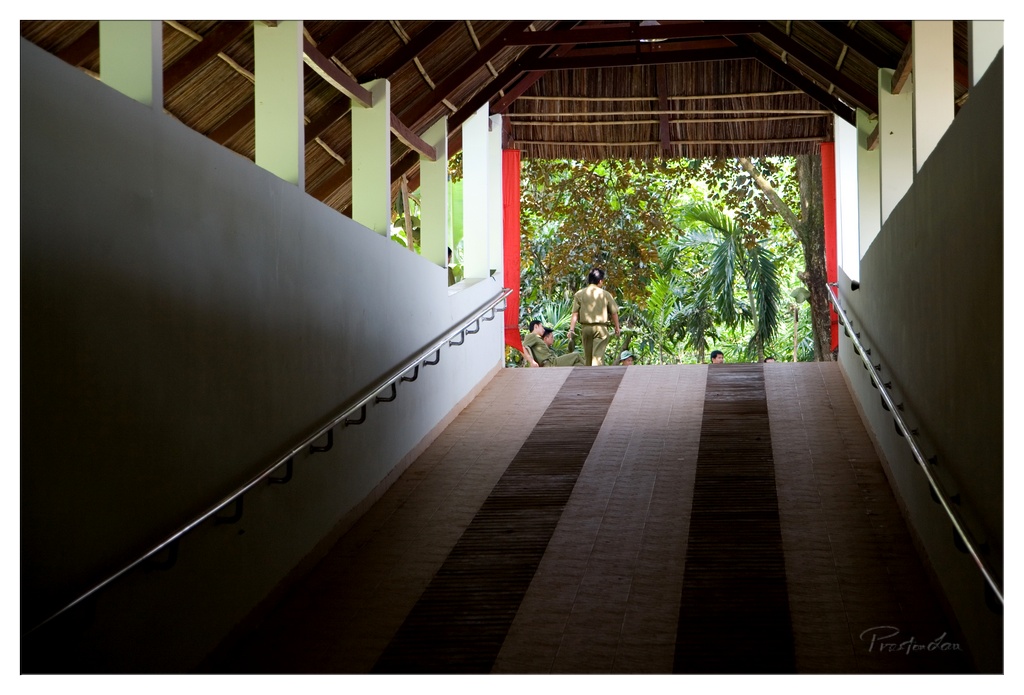

The Path Less Shaded
Rating: 7/10
This image presents a compelling perspective shot down a covered walkway, drawing the viewer's eye towards a bright opening revealing lush green vegetation and a few figures in the distance. The walkway itself, with its distinct alternating light and dark floor tiles and repeating handrail design, serves as the primary subject, creating strong leading lines that guide the composition. The architectural elements, including the simple columns and thatched roof, frame the view beyond, adding to the sense of passing through a structured space into a more natural environment. The scene feels like a transition point, perhaps an entrance or exit from a building or resort area, imbued with a mood that is both peaceful and slightly mysterious due to the dramatic contrast between the shaded interior and the bright exterior.
From a technical standpoint, the composition is quite effective, using the linear elements of the walkway to create depth and direct the gaze. The lighting is a key feature, employing a high-contrast approach that silhouettes parts of the interior and emphasizes the bright world outside. This dramatic lighting adds visual flair but risks losing detail in the brightly lit background area – a common challenge with high dynamic range scenes, though sometimes the blown-out look is intentional for effect. The large, dark wall on the left dominates its side of the frame, acting as a strong visual boundary. While it adds to the feeling of enclosure in the walkway, it also occupies a significant portion of the image. The presence of people in the background provides scale and context, suggesting the space is functional, even if they are too distant to be distinct subjects themselves. It's a strong study in perspective and light, inviting the viewer to imagine the journey along this path.
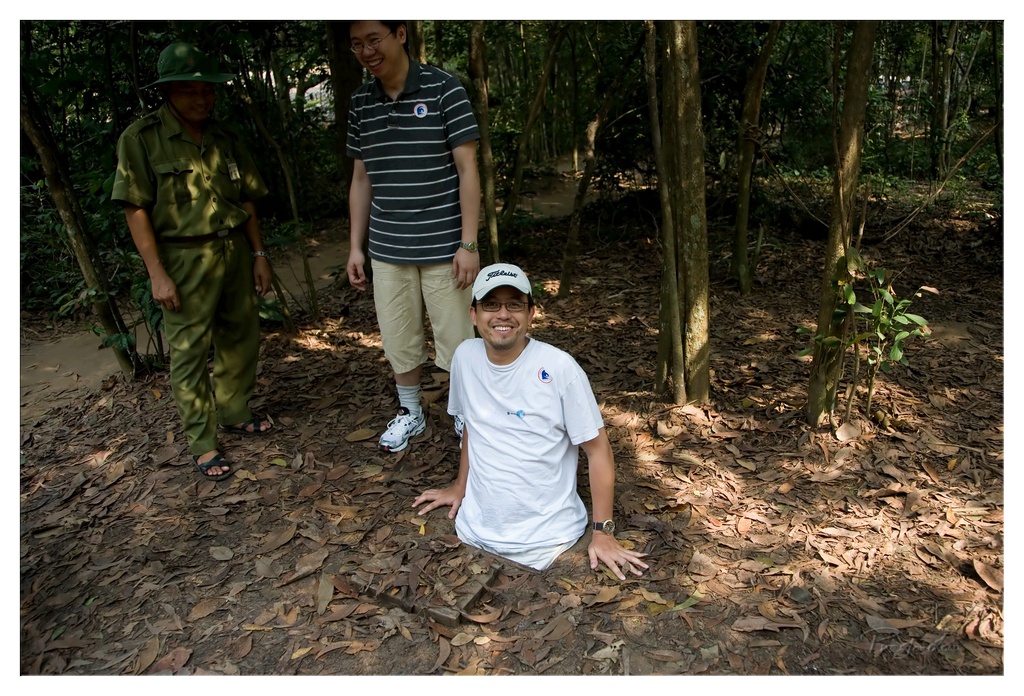

Cu Chi Squeeze
Subject Enthusiasm 9/10
Talk about getting *into* your subject matter! This photograph expertly captures a moment of interactive history as a participant joyfully (or perhaps just very gamely) demonstrates entry into a hidden tunnel entrance, likely at a place like the Cu Chi Tunnels. Our primary subject, rated 9/10 for sheer commitment to the bit and excellent eye contact with the camera, is seen emerging from the ground with a wide smile, framed by the dense leaf litter. Beside him stand a guide in a classic green uniform, providing context and maybe a handrail, and another tourist looking on with what seems like a blend of amusement and relief that it's not them doing the squeeze. The mood is light and humorous, contrasting the serious history of the location with the slightly awkward reality of recreating it.
From a photographer's perspective, the low angle effectively highlights the difficulty and narrowness of the opening, making the hole itself a significant element of the composition. The dappled light filtering through the trees creates a visually interesting pattern on the ground and subjects, though it presents the classic challenge of managing contrast in forest lighting – note the bright highlights and deep shadows. The earthy color palette of greens and browns is true to the environment. While the foreground leaves are slightly busy, they reinforce the natural, camouflaged setting. It's a classic travel photo moment, capturing a specific activity and the participant's reaction, perfect for illustrating the experience of visiting such a historical site.
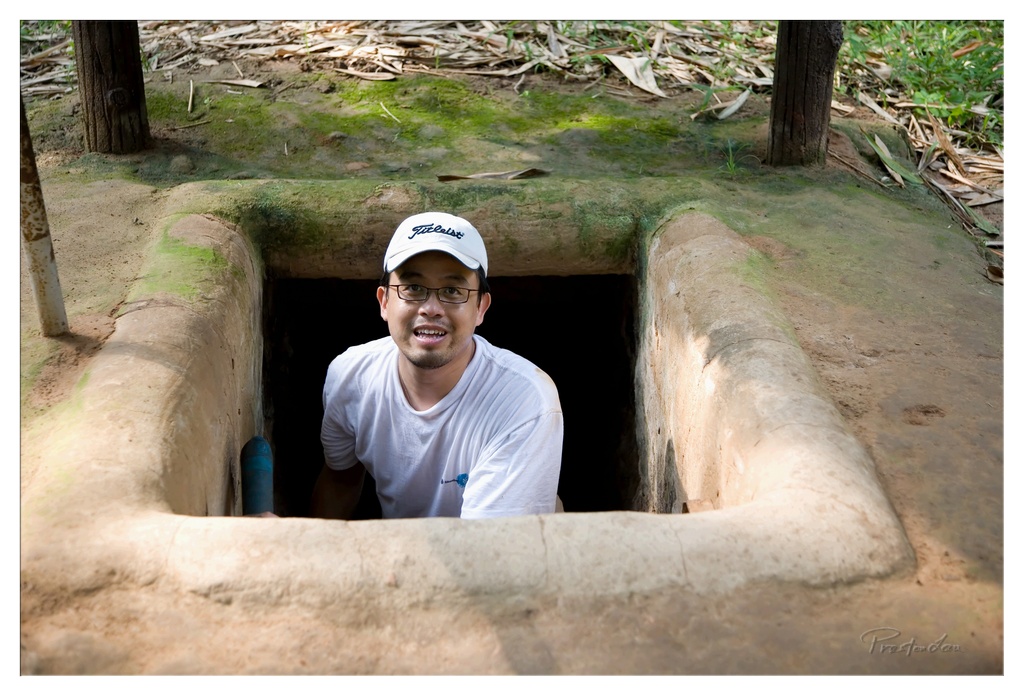

Popping Out of History
Subject Rating: 8/10
Alright, let's analyze this shot! We've got a gentleman here, sporting a crisp white Titleist cap (clearly ready for a round of golf after his subterranean adventure) and a matching white tee, joyfully emerging from a rather earthy-looking hole in the ground. He's got a big, toothy smile and glasses, looking quite pleased with himself for not getting stuck. The mood is lighthearted and adventurous, suggesting a tourist exploring something perhaps a bit tight or unexpected. The entrance is basically a rectangle carved into an ancient-looking dirt mound, surrounded by dried leaves and jungle-like foliage in the background, hinting at a specific historical or geographical location known for... well, holes you can pop out of. There's a hint of a blue pipe or object just inside the entrance to his left, adding a little mystery to the dark abyss behind him.
From a photography perspective, the composition is quite effective. The natural framing provided by the tunnel entrance immediately draws the viewer's eye to the subject, creating a strong focal point. The low angle emphasizes the size of the mound and the depth he's emerging from. Lighting is natural and works well; the sunlight illuminates his face and the immediate surroundings, separating him nicely from the pitch-black interior of the tunnel. This contrast adds visual drama without being overly harsh. The color palette is dominated by earthy browns and greens, which are warm and natural, making the subject's bright white attire stand out. It's a classic example of capturing a moment of exploration and discovery, framed by the very feature being explored, making for a memorable travel portrait, even if it makes you slightly claustrophobic just looking at it.
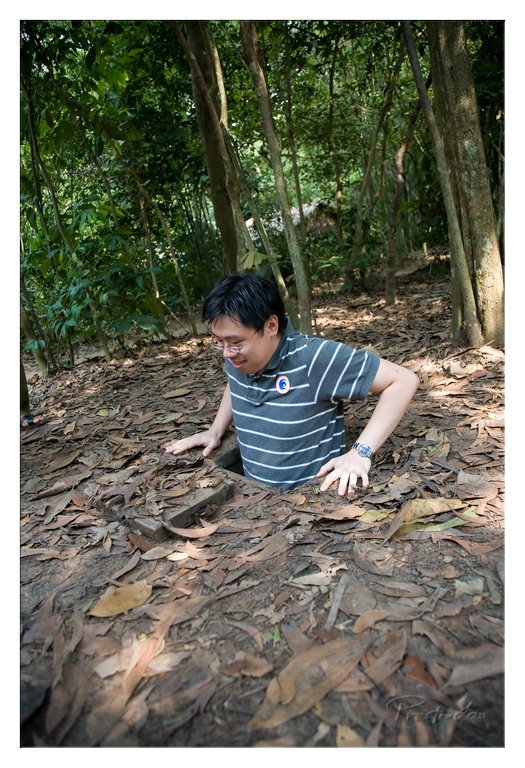

Underground Living - A Snug Fit
Rating: 8/10
Here we have our intrepid subject, emerging (or perhaps attempting to retreat) from a rather discreet opening in the ground, looking like a mole caught in the act. The composition here is quite effective, utilizing a low angle to emphasize the perspective from the ground level, literally putting us in the shoes of someone navigating this earthy environment. The focus is sharp on the man and the immediate surroundings, creating a sense of presence and depth. The natural lighting, dappled through the forest canopy above, adds a touch of drama and highlights the texture of the dry leaves and the man's face, giving it a warm, adventurous tone. While the frame is perhaps a *tad* tight around the subject, it effectively isolates the action and the unique nature of the entrance, leaving just enough of the background trees to set the scene. His expression of curious effort adds a great human element to the image – you can almost hear him muttering about needing more legroom.
From a technical standpoint, the exposure is well-handled given the challenging mix of shadow and light; the details in the leaves and his shirt are preserved without blown-out highlights or crushed blacks. The earthy color palette perfectly reflects the setting, dominated by browns, greens, and subdued natural hues. The pertinent objects here are the hole itself, looking deceptively small, and the man's hands placed on the surrounding dirt, giving a sense of scale and effort. The background is a typical forest scene, hinting at the rural or wilderness location of this hidden feature. The overall style feels like travel or documentary photography, capturing a moment of exploration and interaction with the environment. This shot really encapsulates the slightly awkward but exciting moment of discovering and entering such a confined, hidden space – makes you think twice about complaining about your current living situation!
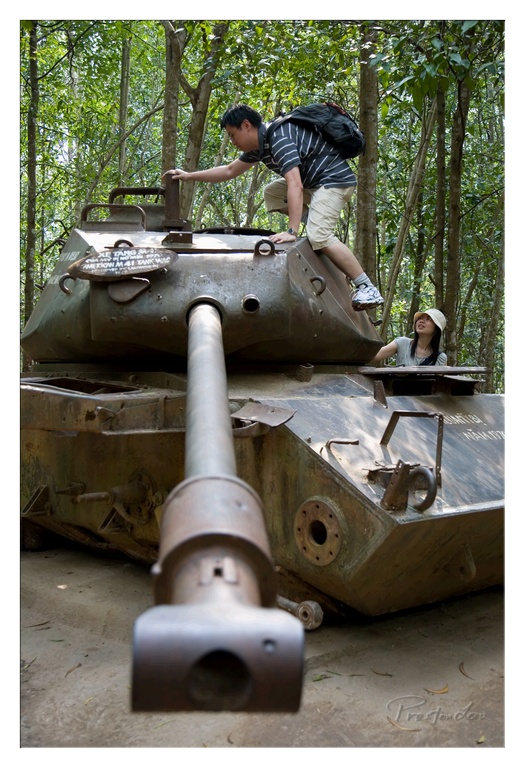

Tank Tourism
Rating: 8/10
This image captures a moment of historical exploration as a man, equipped with a backpack and determination, scales the weathered turret of an old tank nestled within a lush forest. He looks focused on his ascent, his hand reaching for a hold, while his companion observes from below, perhaps offering encouragement or quietly questioning his life choices. The sheer mass of the tank dominates the frame, a relic of past conflict now serving as a quirky climbing frame for adventurous tourists. The mood feels adventurous and slightly humorous, highlighting the contrast between the tank's formidable history and its current role as a photo op backdrop.
From a photographic perspective, the composition is effective, utilizing the long, imposing barrel of the tank to draw the viewer's eye into the scene and up towards the action. The low angle exaggerates the scale of the tank, making the climb seem perhaps more epic than it is, adding to the subtle humor. Natural light filters through the dense forest canopy, creating interesting shadows and highlights on the rusty metal surface, emphasizing its age and texture. The colors are subdued, dominated by the greens of the foliage and the earthy tones of the tank, fitting the jungle setting. The photographer's watermark in the lower right corner subtly asserts ownership over this captured moment of historical interaction.
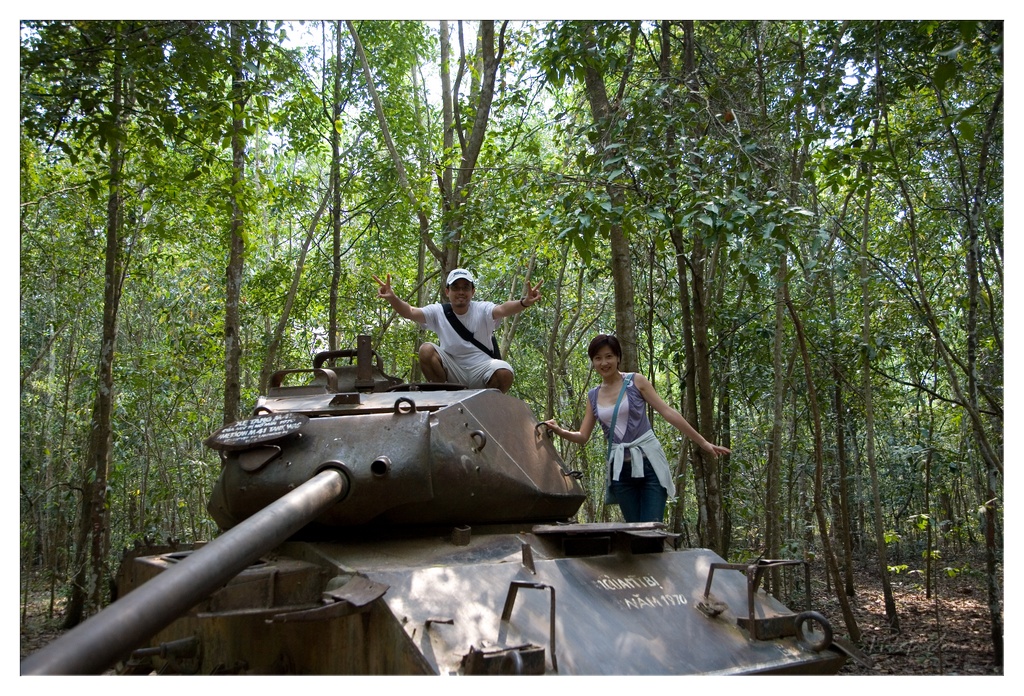

Tank Tourists Extraordinaire!
Subject Rating: 7/10
Our daring duo here scores a respectable 7/10 on the subject scale, mainly for their enthusiasm atop this historical beast. The scene captures a moment of rather cheerful exploration, blending the somber history represented by the weathered tank with the upbeat presence of our subjects. The tank, a sturdy, rusty relic with a prominent barrel dominating the left side, serves as their impromptu stage. Clearly marked with its history (it's a tank ambushed in 1970, just in case you were wondering!), it sits nestled deep within a vibrant, dense forest. The background is a tapestry of tall trees and lush green foliage, creating a sense of being truly immersed in nature, or perhaps a former battlefield now reclaimed by the jungle.
Compositionally, placing the tank front and center grounds the image, with the subjects providing the human element and narrative. The tank barrel provides a strong leading line, albeit aimed slightly out of frame – perhaps a metaphor for history's gaze? The lighting is typical of a forest setting, dappled sunlight filtering through the canopy creating pockets of light and shadow, which adds texture but also makes exposure a touch challenging. Color-wise, it's a study in greens and browns, punctuated by the brighter clothing of the couple. The style leans heavily into travel snapshot territory, capturing a memory. Their poses, peace signs from him, a joyful stretch from her, stand in humorous contrast to the tank's original purpose, making it look less like a war machine and more like a very large, slightly awkward jungle gym. It's a classic "we were here" shot, elevated by the unique prop.
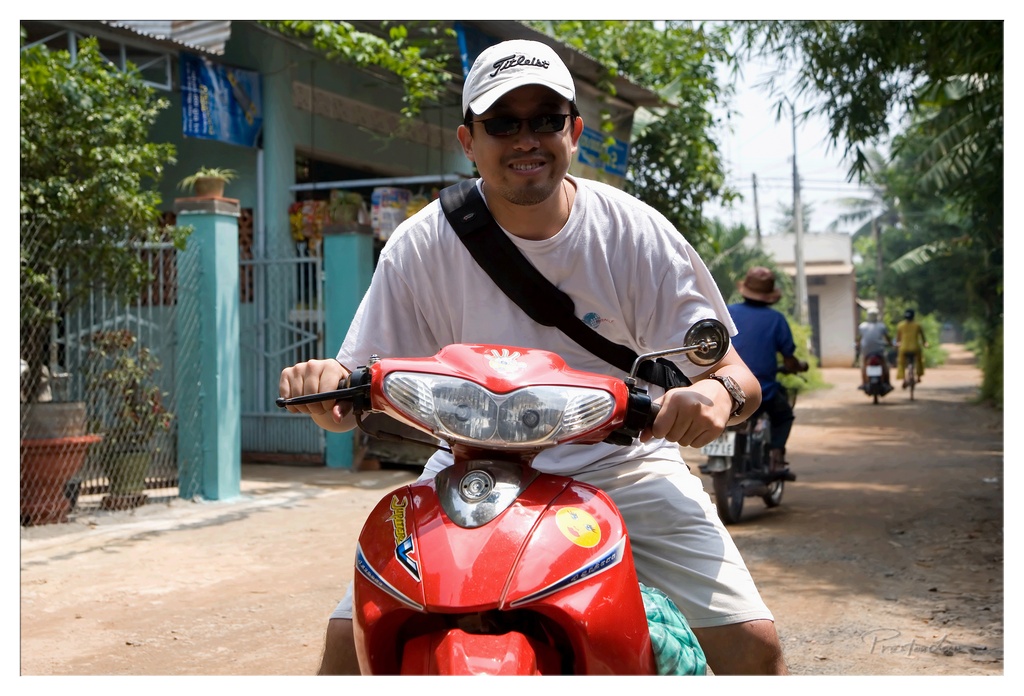

Title: Two Wheels, One Big Grin & The Midday Sun
Rating: Subject 8.5/10
Front and center, astride a gleaming red scooter, is a fellow who looks thoroughly chuffed to be navigating this sunny, possibly Vietnamese, lane. Our subject, sporting a classic white Titleist cap (priorities!) and sunglasses, beams directly at the camera, handlebars gripped like they hold the secret to eternal happiness. He's wearing a simple white tee and shorts, a casual travel vibe reinforced by the strap of what looks like a camera bag slung across his chest – clearly, he's usually on the other side of the lens. The low, slightly angled perspective from just above the scooter's handlebars throws us right into the action, offering a unique, dynamic viewpoint, as if we're about to hitch a ride or perhaps are the photographer themselves, precariously balancing backward.
The bright red of the scooter, complete with 'Jupiter' branding and a couple of smiley stickers, pops vividly, dominating the foreground and drawing the eye. Compositionally, placing the subject centrally works here because his engaging expression and direct gaze create a strong connection, despite the conventional advice against it. The background, rendered with a decent amount of blur (likely shallow depth of field), provides just enough detail to establish the setting – a quiet rural road with simple buildings, lush trees, and glimpses of local life passing by in the form of other vehicles and pedestrians. The midday light, while functional, is a bit unforgiving, creating strong contrasts and shadows, but it effectively highlights the cheerful energy of the scene. It's an energetic, personal shot, capturing a moment of easygoing travel and connection, less a technically perfect portrait and more a vibrant snapshot of a journey in progress.
Loading map...